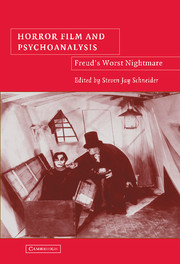Book contents
- Frontmatter
- Contents
- Acknowledgments
- Foreword: “What Lies Beneath?”
- Introduction: “Psychoanalysis in/and/of the Horror Film”
- PART ONE THE QUESTION OF HORROR-PLEASURE
- 1 “What's the Matter with Melanie?”: Reflections on the Merits of Psychoanalytic Approaches to Modern Horror Cinema
- 2 A Fun Night Out: Horror and Other Pleasures of the Cinema
- 3 Excerpt from “Why Horror? The Peculiar Pleasures of a Popular Genre,” with a New Afterword by the Author
- 4 Philosophical Problems Concerning the Concept of Pleasure in Psychoanalytical Theories of (the Horror) Film
- PART TWO THEORIZING THE UNCANNY
- PART THREE REPRESENTING PSYCHOANALYSIS
- PART FOUR NEW DIRECTIONS
- Afterword: Psychoanalysis and the Horror Film
- About the Contributors
- Bibliography
- Index
3 - Excerpt from “Why Horror? The Peculiar Pleasures of a Popular Genre,” with a New Afterword by the Author
Published online by Cambridge University Press: 14 July 2009
- Frontmatter
- Contents
- Acknowledgments
- Foreword: “What Lies Beneath?”
- Introduction: “Psychoanalysis in/and/of the Horror Film”
- PART ONE THE QUESTION OF HORROR-PLEASURE
- 1 “What's the Matter with Melanie?”: Reflections on the Merits of Psychoanalytic Approaches to Modern Horror Cinema
- 2 A Fun Night Out: Horror and Other Pleasures of the Cinema
- 3 Excerpt from “Why Horror? The Peculiar Pleasures of a Popular Genre,” with a New Afterword by the Author
- 4 Philosophical Problems Concerning the Concept of Pleasure in Psychoanalytical Theories of (the Horror) Film
- PART TWO THEORIZING THE UNCANNY
- PART THREE REPRESENTING PSYCHOANALYSIS
- PART FOUR NEW DIRECTIONS
- Afterword: Psychoanalysis and the Horror Film
- About the Contributors
- Bibliography
- Index
Summary
THE RETURN OF THE REPRESSED
By far the most common accounts of horror's appeal are grounded in concepts drawn from Freudian theory, and I shall approach them by focusing first on simple repression models and then on the more elaborate analyses offered by “structural psychoanalysis.” This psychoanalytic emphasis is not recent – though the Lacanian turn in cultural theory has lent it additional force – and it is tempting to speculate as to why, more than with any other popular genre, those puzzled by horror should so often have turned to psychoanalysis in search of enlightenment. In some part, of course, the genre itself invokes psychoanalytic considerations, at times borrowing its imagery from the symbolic apparatus of dream interpretation as well as allowing fictional characters to advance pseudo-Freudian accounts of their own and other's motivations. Thus, where its typical monsters have been compulsive murderers, as so often in the past thirty years, the genre's common presumption has been of a psychopathology rooted in the psychosexual dynamics of childhood. In this respect, at least, Norman Bates long ago escaped the confines of Psycho to leave his distinctive imprint on modern horror.
However, although the genre's self-conscious borrowing from psychoanalysis is not without significance for the theoretical frameworks invoked in its understanding, such an emphasis does not entail any specific theoretical consequences and so hardly explains psychoanalytic theory's predominance.
- Type
- Chapter
- Information
- Horror Film and PsychoanalysisFreud's Worst Nightmare, pp. 55 - 67Publisher: Cambridge University PressPrint publication year: 2004
- 2
- Cited by



